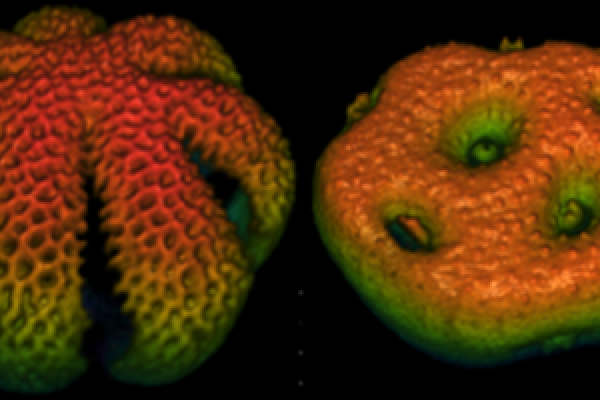Molecular Geneticist Awarded 3-Year $772,000 NSF Grant

Molecular Genetics Assistant Professor Anna Dobritsa’s new, three-year $772,000 NSF grant supports research on processes that are not only interesting to plant biologists, but to materials scientists.
Dobritsa, who also is affiliated with the Center for Applied Plant Sciences, is PI on the project, “Pollen apertures as a model for formation of distinct extracellular domains.” Heather Owen, University of Wisconsin-Milwaukee, is co PI, and Adriana Dawes, assistant professor, molecular genetics, mathematics, and MBI, is a collaborator.
Dobritsa is an expert on cell wall formation in plant pollen grains. Cells rely on the regulated production of extracellular materials to control their shapes, growth, and motility, to promote tissue formation, and to protect themselves.
Despite the importance of extracellular structures in development and disease, the question of how cells decide when, where, and how these materials should be produced and deposited is far from being understood in any system.
Dobritsa’s research team studies the formation of complex extracellular structures using the development of exine — the outer cell wall of plant pollen grains — as a model.
Exine is important for plant reproduction and speciation. It evolved as a protector of male reproductive units, as a pollinator-interacting entity, and as a site of pollen-pistil recognition.
Being able to understand the mechanism of its development could improve manipulations of plant reproduction by controlling pollination.
Not only that, but exine formation is a fascinating system that lies at the intersection of many disciplines. These range from cell and developmental biology to biochemistry and evolutionary biology to materials science and molecular engineering.
Exine’s unique composition is different from other plant cell walls. It is made of sporopollenin, a biopolymer unparalleled for its strength, elasticity and chemical durability; this makes it an exciting system to study.
To-date, both sporopollenin’s chemical structure and the genetic and biochemical networks that control its production are poorly understood.
Because of this biopolymer’s remarkable material properties, understanding the processes responsible for sporopollenin synthesis is interesting not only to plant biologists, but also to materials scientists.
“Exine contains species-specific adhesives that participate in strong and selective binding between male pollen and receptive female stigma cells and are possibly involved in speciation,” Dobritsa said.
“While the identity of adhesives is unknown, their chemical and physical properties suggest that they are unlikely to be proteins, implying that exine mediates a very unusual type of cell-cell recognition.”
Understanding the nature of sporopollenin and exine could result in the creation of strong and specific glues and of materials with exine-like nano- and micro-patterns.
Dobritsa’s team is intent on doing just that. “We are trying to learn how sporopollenin is synthesized, exine is developed, exine patterns are laid out, and eventually would like to understand how the forms of these complex structures determine their functions,” she said.
And, to answer these questions, they utilize every possible tool: genetics, molecular biology, biochemistry and confocal and electron microscopy, along with having access to another exceptional asset.
“We have a large collection of Arabidopsis exine mutants that help us to identify and study molecular players and events involved in sporopollenin biosynthesis and exine formation,” Dobritsa said.
“In the future, these data from this model plant will be used as a foundation for evo-devo * studies regarding the generation of the enormous variety of exine patterns observed in nature.
“The NSF award will allow us to study formation of patterns on pollen surfaces by concentrating on a particular patterning element — pollen apertures.
“Pollen grains from different species often look remarkably different — in part, because wall materials are deposited at some places on the pollen surface and are absent from the others.
“The places where the pollen wall is absent are called apertures, and these structures help pollen perform its reproductive function.
“Across species, pollen apertures often differ in shape, number and positions, but within a species aperture patterns are usually the same.
“This suggests that, in a given species, developing pollen can consistently mark some of its surface regions as different from the rest of the surface, so that only certain areas will develop into apertures.”
Using formation of pollen apertures as a model, this project will investigate how cells determine which surface areas will lack extracellular structures and how positions of such areas are defined.
—Sandi Rutkowski
*Evo-devo is a field combining two areas of biology, evolutionary biology and developmental biology, into one, comparing developmental processes of different organisms to determine ancestral relationships between them and fill in more blanks about how developmental processes evolved.
